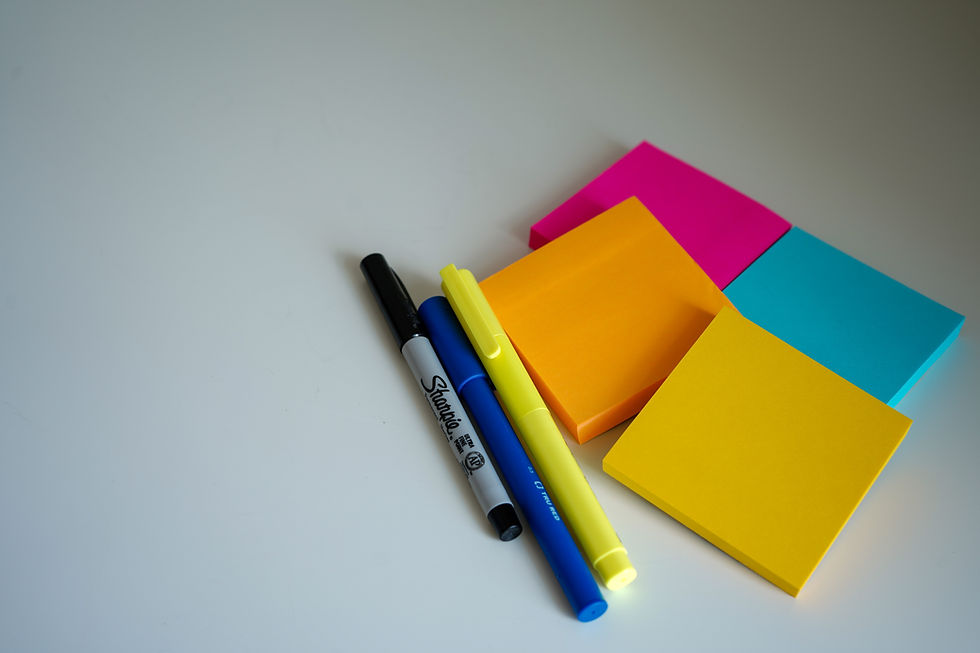Ideation without suffering
- Livia Santos Germano

- Oct 23, 2021
- 4 min read
What can we do when the pain of the creation process becomes so acute that the pressure to create overwhelms the possibilities of free exploration?

I have participated in a series of ideation sessions, both as a participant and as a facilitator, and I realize that most of the time there is always a tension in the air: will people “produce” ideas and truly innovative solutions? Will I, as a member of this team, be able to handle this? Will I be able to come up with brilliant ideas that not only contribute to solving the proposed challenge, but also reflect a positive image about who I am and my creative potential?
Post-its pads, sharpie pens and an endless white wall, with an infinite background, - or Mural canvas, in hybrid times! -, asking to be frantically filled with insights and ideas that can change the direction of a company, create a disruptive product or service, can take on a somewhat intimidating look for many people - especially when the boss or the customer is there, being part of the creative team. At these times, the thing definitely MUST yield and what was supposed to be a moment of experimentation, free thinking and doing can turn into torture and suffering, so much expectation and pressure placed.
Flow: pleasure and efficiency
Created by the Hungarian psychologist Mihaly Csikszentmihalyi, the Flow Theory seeks to understand what an individual needs to achieve a full state of satisfaction, concentration and motivation inherent in performing a task. Csikszentmihalyi describes a state of total engagement, where people are one hundred percent present and focused. He called this state of mind the ideal experience, a flow that allows us to perform tasks that challenge our abilities with pleasure and efficiency.
Csikszentmihalyi developed his theory from interviews with professionals who performed activities considered intrinsically motivating and pleasurable, such as artists, musicians, athletes and chefs. These are activities that lead to intense feelings of joy and personal satisfaction. During his research, he found that despite working in different fields and belonging to very different cultures, many of these professionals reported experiencing a similar feeling while doing their jobs. It was a feeling of complete absorption in the tasks they needed to accomplish, often ignoring physical sensations like hunger, thirst or sleep. The concentration they achieved was so great that they didn't see time pass, reporting that hours passed as if they were minutes.
According to the psychologist, this state of complete involvement would only be possible under specific conditions and has four basic principles for its realization: balance between challenge and skill (that is, it is not so difficult that we give up, nor so easy that we get bored), clear goals , feedback on actions and the possibility of full concentration on the activity and the present moment.
Motivation and engagement to create is something personal
In my practical experience as a facilitator of co-creation sessions, I realized that another factor that amplifies this tension in creating for a non-positive side is the lack of creating an environment of creative trust, associated with the use of resources that do not motivate or encourage people to create in a state of flow - basically, resources that don't enhance their innate abilities.
When I talk about lack of resources, I assume that today, in general, the same resources or languages are used to encourage people who have different mindsets and skills to create: written language, posts its, rationality and pragmatism.
These tools allow people to exercise only one way of ideating, a single skill, disregarding that there may be people who are engaged, inspired and better express themselves through other languages, such as drawing, the use of images, gamification, storytelling, the use of metaphors, manual work and so on, with so many other forms of expression.
Each person creates, produces, has insights from different triggers, makes use of different forms of expression and uses different skills. Mental processes are different between people, with each connecting ideas and connecting with each other in different ways.
I keep thinking that processes that seek to place people much more in a module of rationality and pressure for the volume of ideas than in the abstraction and exploration of possibilities, can bring a false sense of control of results and limit the real potential of creation, by opening hands of more playful and experimental techniques and tools.
Combining a variety of tools, methods and triggers within an ideation session is an important point of attention to be considered by facilitators when designing and facilitating co-creation processes. Consider these individualities to make available to participants resources, stimuli and tools that reinforce skills and are sources of inspiration so that people with different profiles can flow together.
Designing a work session demands knowledge and sensitivity to define the best tools and methods to be used to get the best out of the creative team. Define the best stimulus or tool for each profile and skill to reach the intentions and expected results. The environment and workspace also have a big influence. Orchestrating all these variables is something challenging for a facilitator, but fundamental to building a safe environment and a feeling of trust to create, together with the project team, against the background of building a constructive and pleasant process. And this has a direct impact not only on the results, but above all on the journey of creation, taking the pain out of creating to make room for the pleasure of creating and exploring possibilities, something inherent to the creative process.
Summary

Sincera Space was created to be your creative and strategic space of strength, to help you flow and lead your work team in a state of flow.
Our methods and tools give you structure and confidence for you to experience possibilities and arrive efficiently and fluidly at the results you seek to achieve. Find out more here.


Comments